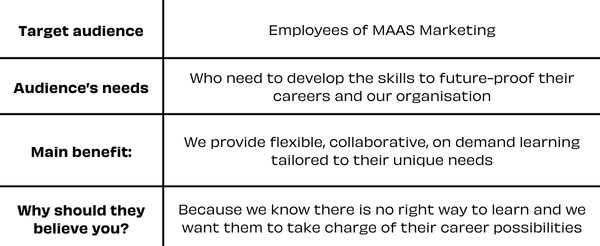want some cookies?
We use cookies to make your browsing experience amazing.

L&D teams worldwide are focusing more and more on their brand and reputation. And one of the best ways to achieve this is by creating a positioning statement for your L&D team. Positioning statements are built from your value proposition canvas and your brand promise, and describes how you fulfil the needs of your target audience. The goal of a positioning statement is to align marketing efforts with a company's (or in your case, team’s!) brand and value proposition.
Let’s look at an example of a positioning statement from Nike:
"For athletes in need of high-quality, fashionable athletic wear, Nike offers customers top-performing sports apparel and shoes made of the highest quality materials. Its products are the most advanced in the athletic apparel industry because of Nike's commitment to innovation and investment in the latest technologies."
Nike’s positioning statement is clear, impactful and
to the point. It considers the how, what and why of their
offering. And it’s for this reason that positioning statements are so important in L&D. So let’s look at creating one together, shall we?
*ooo I love a bit of team work*
CREATING YOUR L&D POSITIONING STATEMENT
HubSpot have created a template for creating positioning statements – giving us a great place to start:
For [your target audience] who [target market need], [your brand/product name] provides [main benefit that differentiates your offering] because [reason why target audience should believe in your differentiation statement].
So we have 4 key questions to answer:
- Who is our target audience?
- What are their needs?
- What is the main benefit of our learning offering?
- Why should our audience believe us?
The first three questions are answered in your VPC, so we actually only need to create one piece of our positioning statement, and then piece it all together. #Winning
But it’s that final part that most L&Ders struggle with. For decades L&D have lived in a bubble where we believe people should believe us and use our content – because we said so. But our audiences have wised up to this. And they won’t take “because we said so” any more.
It’s time to really think about why your audience should believe you and get involved with our learning offering. We can’t tell you the answer to that right now (not without doing some deep discovery work with your team), so for now, this is a point of self-reflection... but reviewing your VPC will help!
But to help you on your way, let’s dissect a few positioning statements to see how they work:
First, let’s put HubSpot’s template to work and break down Nike’s positioning statement:

We can see how that works. But in L&D we often haven’t got a lot of time and money to invest in the latest tech or innovation, do we? So that doesn’t help us with the ‘why?’ Let’s look at another example, this time from Mural…
"For organisations who need visual collaboration at scale, Mural helps you bring imagination to work from anywhere with agile and design thinking methodologies, sales and consulting, and research and design, all in one platform. Join a growing network of global enterprises, consultancies, schools, and nonprofits using Mural to innovate."
And let’s break this down into the template again…

Okay, that’s social proof and a firm reason why their audience should believe. But not all L&D teams have a growing network of learners, so let’s look at a hypothetical example for L&D…
A MADE UP L&D TEAM’S POSITIONING STATEMENT
We don’t have an L&D team here at MAAS. But if we did, a first draft of our L&D positioning statement might look a lil’ like this:
For employees of MAAS Marketing who need to develop the skills to future-proof their careers and our organisation, we provide flexible, collaborative, on demand learning tailored to their unique needs because we know there is no right way to learn and we want them to take charge of their career possibilities.
Let’s distil this down into our grid, to check we’re hitting all the right marks!

Woohoo, that works! But it’s a bit of a mouthful isn’t it? So let’s put our marketing hats on and make it sound a bit better…
“MAAS Marketing gives our people the opportunity to learn, network and connect with their colleagues across the globe, helping us strive towards a future of collaboration, forward-thinking and growth. We know there is no ‘right’ way to learn. So our people are in charge, choosing their own learning journeys, format and timeline to make sure they are prepared for growth.”
Much better! The same message is portrayed, but it’s less clunky and keeps attention. Exactly what we want!
Creating a positioning statement does take some time, but it unifies your team, your product and your audience. And ultimately – it makes sure you have a product or service ready to be marketed!
DELIVERING ON YOUR POSITIONING STATEMENT
But the truth is, all of this will be a waste of time and effort if you don’t put the work in to make it a reality.
You need to have the team structure, collaborative culture and support network to really bring it to life. So now is the time to think about your team a little bit. Notably:
YOUR CAPACITY & STRUCTURE
Your team’s structure, and its ability to support strategic goals. For example, do you have the capacity in your team to deliver on your brand promise, alongside your other priorities?
BUSINESS RELATIONSHIPS
Do you have relationships with other functions to truly understand their wants, needs and fears — to ensure that your product meets their requirements?
SUPPORT NETWORK
Have you established a support network across the organisation that will amplify your brand, and your brand promise? We all need advocates to succeed!
IS A POSITIONING STATEMENT WORTH IT?
Simple answer: yes.
Longer answer: absolutely, but only if you’re willing and ready to put in the time and effort to make it a reality. You need to embody your positioning statement in all you do. So, if you want to continue being an order-taking department, or a content-churning function, then your positioning statement won’t be worth the paper it's written on. But if you’re ready to be a trailblazer, and do something truly different – then a positioning statement is a great place to start.









